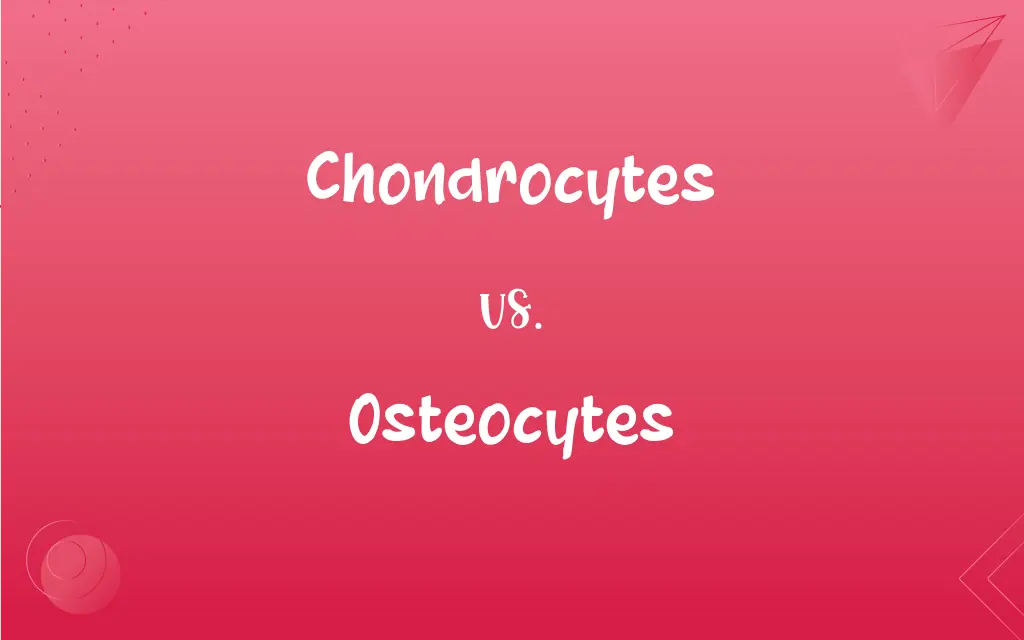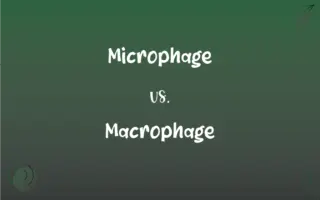Chondrocytes vs. Osteocytes: What's the Difference?
Edited by Aimie Carlson || By Harlon Moss || Published on January 9, 2024
Chondrocytes are cells found in cartilage, while osteocytes are cells located in bones.

Key Differences
Chondrocytes are the primary cell type found in cartilage, responsible for maintaining cartilaginous matrix. Osteocytes, on the other hand, are mature bone cells, crucial for maintaining bone tissue. Both cell types play key roles in the skeletal system but are found in different types of tissues.
Chondrocytes are embedded in a gel-like matrix that provides flexibility and cushioning in joints. In contrast, osteocytes reside in a rigid, mineralized matrix that gives bones their strength and structure. While chondrocytes facilitate movement, osteocytes provide support and structure to the body.
The origin of chondrocytes is from chondroblasts, cells that produce cartilage. Osteocytes evolve from osteoblasts, the bone-forming cells. This difference in origin reflects their distinct functions in cartilage and bone formation, respectively.
Chondrocytes are involved in the synthesis of collagen and proteoglycans, essential for cartilage health. Osteocytes, conversely, play a role in bone remodeling and calcium homeostasis. Each cell type thus contributes uniquely to the maintenance and health of the skeletal system.
In terms of regeneration, chondrocytes have limited ability to repair damaged cartilage due to avascularity. Osteocytes, in contrast, are part of a vascularized system, allowing for more effective bone healing and remodeling. This difference highlights the regenerative capacities of cartilage versus bone.
ADVERTISEMENT
Comparison Chart
Location
Found in cartilage
Found in bone
Origin
Develop from chondroblasts
Develop from osteoblasts
Function
Maintain cartilage matrix
Maintain bone tissue
Matrix Type
Gel-like, flexible
Rigid, mineralized
Regenerative Capacity
Limited due to avascularity
Higher due to vascularization
ADVERTISEMENT
Chondrocytes and Osteocytes Definitions
Chondrocytes
Chondrocytes can divide in response to cartilage damage but have limited repair capabilities.
Injured cartilage relies on chondrocytes for repair, though the process is slow.
Osteocytes
Osteocytes are mature bone cells involved in the regulation of bone density.
Osteocytes help maintain the strength and integrity of bones.
Chondrocytes
Chondrocytes are cells that form and maintain cartilage tissue.
Chondrocytes play a vital role in the growth of healthy cartilage.
Osteocytes
Osteocytes originate from osteoblasts and become embedded in bone.
Once osteoblasts embed in the bone matrix, they mature into osteocytes.
Chondrocytes
Chondrocytes reside in small spaces called lacunae within the cartilage.
The lacunae provide a space for chondrocytes to function effectively.
Osteocytes
Osteocytes reside in spaces called lacunae within the bone matrix.
The lacunae in bones provide a habitat for osteocytes.
Chondrocytes
Chondrocytes produce the extracellular matrix of cartilage, including collagen.
Chondrocytes are crucial for synthesizing the components of cartilaginous tissue.
Osteocytes
Osteocytes communicate with other bone cells to regulate mineral content.
Osteocytes play a crucial role in the body's calcium regulation.
Chondrocytes
Chondrocytes are vital for the growth and maintenance of flexible joint cartilage.
Healthy joints depend on the activity of chondrocytes in the cartilage.
Osteocytes
Osteocytes have long cell processes that extend through canaliculi in bone.
The network of canaliculi allows osteocytes to communicate and receive nutrients.
Chondrocytes
Plural of chondrocyte
Osteocytes
A branched cell embedded in the matrix of bone tissue.
Osteocytes
Plural of osteocyte
FAQs
How do chondrocytes and osteocytes differ in location?
Chondrocytes are located in cartilage, while osteocytes are found in bone.
What is the primary function of chondrocytes?
Chondrocytes maintain the cartilaginous matrix and produce collagen.
What role do osteocytes play in the body?
Osteocytes regulate bone remodeling and calcium homeostasis.
What are osteocytes?
Osteocytes are mature bone cells that regulate bone density.
How do osteocytes contribute to bone healing?
Osteocytes participate in bone remodeling and repair, facilitating healing.
What happens to chondrocytes in osteoarthritis?
In osteoarthritis, chondrocytes can degrade, leading to joint cartilage breakdown.
What are chondrocytes?
Chondrocytes are cells that form and maintain cartilage.
Are chondrocytes involved in producing bone tissue?
No, chondrocytes are specific to cartilage production and maintenance.
How do chondrocytes affect joint health?
Chondrocytes are essential for maintaining healthy, flexible joints.
Can chondrocytes regenerate cartilage effectively?
Chondrocytes have limited regenerative capacity due to the avascularity of cartilage.
Do chondrocytes have a role in growth plates?
Yes, chondrocytes are involved in the formation and function of growth plates in bones.
What is the role of osteocytes in age-related bone loss?
Osteocytes contribute to bone density regulation, which can be affected in age-related bone loss.
Where do chondrocytes originate from?
Chondrocytes develop from chondroblasts, the cells that form cartilage.
What is the origin of osteocytes?
Osteocytes evolve from osteoblasts, the bone-forming cells.
What is the significance of osteocytes in bone health?
Osteocytes play a crucial role in maintaining bone strength and structure.
How do osteocytes respond to mechanical stress?
Osteocytes sense mechanical stress and signal for bone remodeling as needed.
Can chondrocytes be used in cartilage repair therapies?
Yes, chondrocytes are often used in regenerative therapies for cartilage repair.
How do osteocytes maintain bone homeostasis?
Osteocytes maintain bone homeostasis by regulating mineral content and communicating with other bone cells.
Do osteocytes help in forming cartilage?
No, osteocytes are exclusively involved in bone tissue regulation.
What are the limitations of chondrocytes in cartilage repair?
The limitations stem from their slow division rate and the avascular nature of cartilage, hindering effective repair.
About Author
Written by
Harlon MossHarlon is a seasoned quality moderator and accomplished content writer for Difference Wiki. An alumnus of the prestigious University of California, he earned his degree in Computer Science. Leveraging his academic background, Harlon brings a meticulous and informed perspective to his work, ensuring content accuracy and excellence.
Edited by
Aimie CarlsonAimie Carlson, holding a master's degree in English literature, is a fervent English language enthusiast. She lends her writing talents to Difference Wiki, a prominent website that specializes in comparisons, offering readers insightful analyses that both captivate and inform.






































































